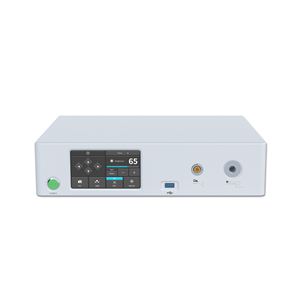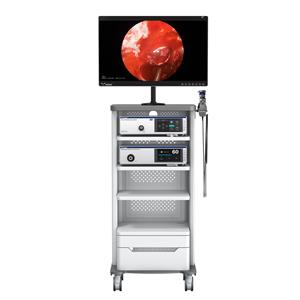【Hysteroscope】Hysteroscopic myomectomy
Uterine fibroids are a common benign tumor in women. Although uterine fibroids are benign tumors, they can seriously affect the health and quality of life of women of childbearing age, and can even cause infertility, spontaneous abortion, premature delivery, and dystocia. With the rapid development of minimally invasive techniques, hysteroscopic myomectomy has been widely used.
1. Anesthesia
2. Preoperative preparation: Patients must undergo hysteroscopy and curettage, cervical smear, gynecological examination, B-ultrasound examination and vaginal cleaning before surgery, and cervical intubation before surgery.
3. Position and disinfection: Take the bladder lithotomy position, the patient lies on his back, his legs are placed on the leg rest, and his buttocks are moved to the bed. Routinely disinfect the vulva and upper 1/3 of the thigh, and lay a surgical towel.
4. Surgical steps:
(1) Pedicled submucosal uterine fibroids: Before cutting, see the anatomical relationship between the fibroids and the surrounding muscle walls, find the pedicle of the fibroids, and use the ring electrode and (or) the rolling ball electrode to electrocoagulate the surface of the fibroids. Large blood vessels and tumor pedicle vessels to reduce intraoperative bleeding. Small size (diameter <3cm) can be cut, clamped, twisted, stretched, and delivered with five-step resection under the guidance of B-ultrasound. For the larger ones (diameter>3cm), first use the ring electrode to cut the tumor body in slices to reduce the size of the fibroids, and divide the fibroids into several pieces, and then use the five-step method to completely remove the fibroids.
Five-step technique:
①Cutting: Use ring electrodes to cut antegrade or retrograde at both ends of the maximum free diameter of the fibroids to reduce the volume of the fibroids, and cut out an "X"-shaped honeycomb-shaped depression, which is suitable for clamping by the leaves of the oval forceps. If the diameter of the fibroids is greater than 4cm, the fibroids can be divided into several longitudinally with horizontal electrodes to facilitate clamping.
②Clamping: Under the guidance of B-ultrasound, insert the oval forceps into the intrauterine cavity to clamp the fibroids and pull them downwards. If the B-ultrasonic examination shows that the uterus moves downwards, the surgeon feels heaviness in the hands, suggesting fibroids Has been clamped. If the fibroids are large and difficult to clamp or slip off, it is necessary to continue the electric resection to reduce the size of the fibroids before clamping.
③ Twist: Turn the handle of the oval forceps clockwise or counterclockwise to separate the fibroids from their base.
④Training: basically at the same time as twirling fibroids, but in the initial stage there is more twirling and less traction, and in the later stage, more traction and less twirling.
⑤ Delivery: In the process of pulling downwards, B-ultrasound indicates that the fibroids are gradually descending to deliver. If the fibroids are large and difficult to pass through the cervical canal, you can use conventional scalpels or scissors when the fibroids are exposed to the external cervix. The fibroids are cut by imitating the "peel off the banana" method, and the size is reduced before delivery.
(2) Unpedicled submucosal uterine fibroids: Some fibroids are located in the muscle wall. To completely remove fibroids, first of all efforts must be made to increase the protrusion of submucosal fibroids. Under the close monitoring of ultrasound, a ring electrode is used to gradually incise the membrane at the bottom of the fibroids to clarify the boundary layer between the fibroids and the muscle layer. The tip of the scope can be used to compress the fibroids while bluntly peeling off the muscle layers. . Due to the high-frequency electrical stimulation and the contraction of the uterine muscle, as well as the insertion and removal of the resection scope, the pressure in the uterine cavity changes, which promotes the protruding of the fibroids into the uterine cavity. When the resection reaches a certain level, you can switch to a five-step technique to complete the operation.
(3) Intermural fibroids close to the uterine cavity: first incise the mucosa and muscle layer closest to the fibroids, that is, "open the window" or "decompress", and use the ring electrode to remove the fibroids that gradually protrude into the uterine cavity. , While using oxytocin to force the fibroids to protrude into the uterine cavity, the subsequent treatment is the same as the sessile submucosal uterine fibroids.
(4) Adenoid fibroids: In rare cases, intramural fibroids or sessile submucosal fibroids diagnosed by clinical or B-ultrasound examinations are actually adenomyomas. There are three types of adenomyoma: ①The mass structure is all adenomyoma tissue, the mass has no obvious capsule, and the cut surface shows clusters of endometrial membrane, old blood and abundant blood vessels. During the resection, adenomyoma will follow The uterus is deformed due to contraction and resection. ②Adenoid fibroids combined with leiomyomas; ③Mixed type, mainly leiomyomas, with endometrial invasion at one end near the uterine cavity. The second and third types of capsules are generally more obvious, and the resection method is the same as that of the intramural fibroids and (or) sessile submucosal fibroids.
Hysteroscopy can directly observe the shape, color, occurrence location, thickness, single or multiple pedicles of submucosal fibroids, as well as the endometrial coverage on the surface, and the degree of fibroids protruding into the uterine cavity. Decide whether it is suitable for hysteroscopic surgery, and if necessary, perform a biopsy under direct vision, except for malignant lesions. Protruding intermural fibroids can show uterine cavity deformation, irregular or bilateral uterine horns and asymmetry of the position of the oviduct opening.




